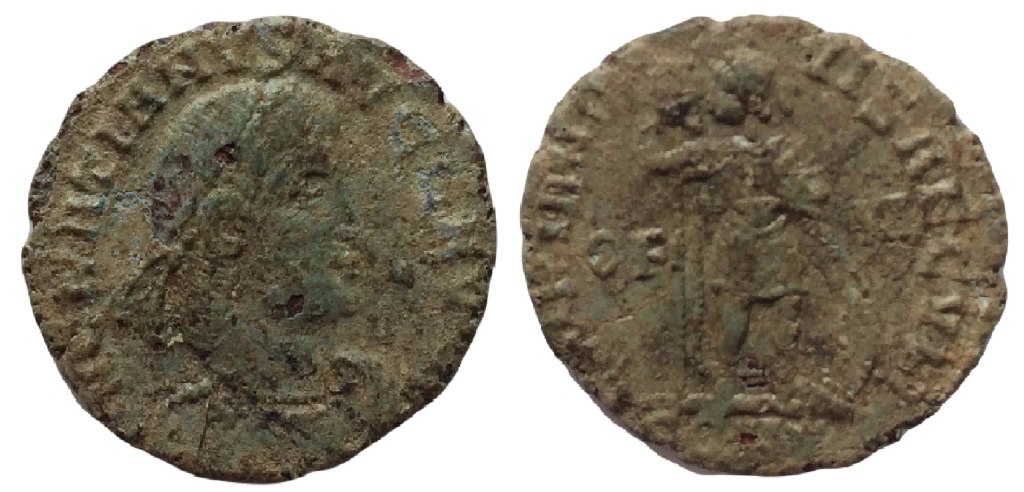April 17, 2015, by Will Leveritt
On this day in 359, the emperor Gratian was born
Text by Rob Stone
Image by Hattie Lander
On the 18th April, AD 359, the Roman emperor Gratian was born at Sirmium, in what was then the province of Pannonia Secunda. Beginning at the age of eight he ruled for eight years (367-75) as junior emperor of the western half of the Roman Empire, alongside his father, Valentinian I. After his father’s death he ruled for another eight years (375-83) as senior emperor of the West. On the 3rd October 382, he saved the Roman Empire.

AE3 of Gratian. Obverse has diademed head of emperor right, D N GRATIANVS AVG G AVG. Reverse has Gratian, head left, holding labarum and shield. 3.2g, 18.4mm, 6 o’clock.
However, Gratian’s campaign in the West was overshadowed later in the year by events in Thrace; Valens had agreed that a large number of Visigoths could be settled within the Empire but had failed to disarm them or provide them with the supplies they needed to survive while they waited for re-settlement. The Visigoths revolted against Valens and, having gathered a number of Gothic and Hunnic allies, set about pillaging the Empire. Rather than wait for his nephew to send military support, Valens met the combined Gothic army at Adrianople and was killed alongside two thirds of the Eastern Empire’s army.
With the Goths running rampant across the Balkans, the nineteen year-old Gratian needed the help of an experienced soldier. He therefore promoted his general Theodosius to the rank of emperor in effect tasking him with wiping out the barbaric threat and securing the East.
Two years later, with Theodosius’ makeshift army having made little headway, Gratian took it upon himself to put down the Goths without the aid of his co-emperor. He failed. By 382, however, Gratian had decided upon a new course of action. He came to the conclusion that if he could not wipe out the Goths, he might at least turn them against Rome’s enemies. A treaty was signed and the Goths were allowed to settle on Roman land; in return they agreed to supply the Romans with troops.
Although settling enemies within the Empire was by no means an innovation (the practice can be traced as far back as Augustus) the fact that the Goths were allowed to remain one large, armed, and semi-independent group inside Roman territory was a sign of things to come. Over the next century many more barbarian tribes would be settled within the borders of the Roman Empire; in the absence of powerful imperial armies, they would be recruited as war bands to serve during an emperor’s campaigns, but proved just as likely to attack the emperors as the enemy.
Gratian had, therefore, secured the immediate future of the Empire. The Goths, who had toppled Valens, had been settled and given the farmland they had desired when they first crossed the Danube. Over time they would even replace the troops they had killed in the Eastern army. However, the terms of the treaty itself marked another step on the path towards the collapse of the Western Empire.
Not that this would matter to Gratian: the time he had spent away from his western dominions fighting the Goths had weakened his position there and allowed a usurper named Magnus Maximus to rise up. Having returned westward, Gratian met Magnus in battle outside Paris. His troops deserted him and he was defeated. He fled to Lugdunum (modern-day Lyons) where he was assassinated by a certain Andragathius, a supporter of Magnus, on 25th August 383; thus ended his short but critical reign.
No comments yet, fill out a comment to be the first

Leave a Reply